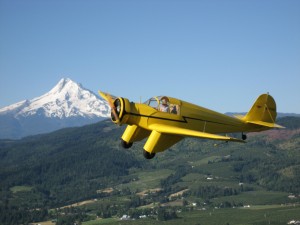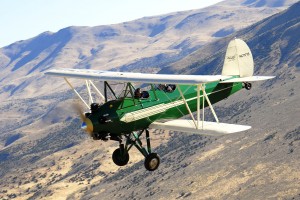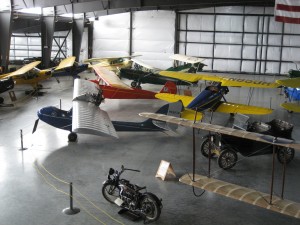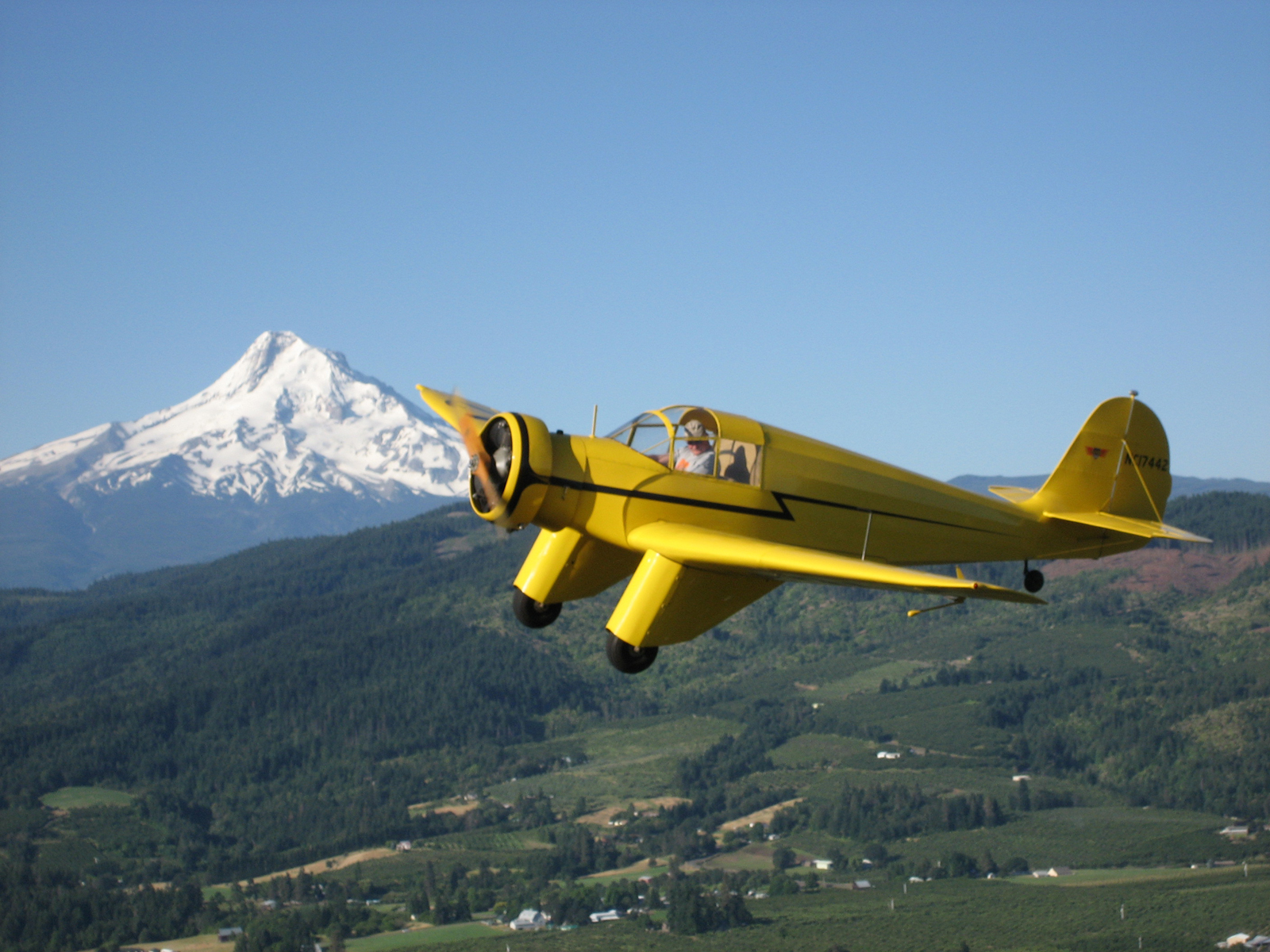
The Western Antique Aeroplane & Automobile Museum’s collection of flying relics includes this rare 1937 Aeronca LC, passing by Oregon’s Mount Hood.
By Terry Stephens
Terry Brandt’s new Western Antique Aeroplane & Automobile Museum is the latest addition to the Pacific Northwest’s dozen aviation museums. Located at Hood River, Ore., it’s unlike any of the others.
All of the 46 rare historic aircraft he’s collected over the past 50 years are maintained in flying condition, including a 1917 JN4D Curtiss Jenny, with serial number 001, and a 1928 Waco GXE 10. The dozen superbly restored cars and the half-dozen military jeeps on display are also taken for a spin periodically.
“It’s a living museum,” said Jeremy Young, museum director. “We keep aircraft and cars operating regularly. We want to inspire our visitors with the history of these exhibits and their role in the early years of aviation and ground transportation. This has been Terry’s dream. Without his collection, WAAAM would never have been built. And, without the museum, he knew he’d have to auction his lifelong collection.”
Designed to honor the memory of early aviators from WWI and WWII, barnstormers, air mail pilots and early pioneers, the museum features one of the nation’s largest collections of flying antique planes. Built by Travel Air, Piper, Taylorcraft, Spartan, Buhl, Ryan, American Eagle, Waco, Davis and others, the planes all flew to their new museum, leaving a crowded 15,000-square-foot storage facility in Hood River, where Brandt and his wife, Lois, live.
Antique cars on display range from a 1914 Ford Model T Depot Hack to Model As and early vehicles from Dodge, Mercury and Studebaker. There’s also a collection of aircraft engines, propellers, cockpit instruments, military vehicles and WWII weapons. The museum has a large research and restoration library filled with a wide-ranging collection of aviation and automotive books and magazines.
Visitors see Aeroncas, not Avengers

This beautifully restored 1931 Curtiss Wright Travel Air 12-W heads toward its new home at Hood River’s new aviation and auto museum.
Although there are some early military aircraft, the museum’s primary focus is historic general aviation aircraft. Brandt’s world was airports and Aeroncas, not aircraft carriers and Avengers. The founder and president of the nonprofit museum was born in Yuba City, Calif., not far from where his parents, Dick and Bee, operated the FBO at Yuba County Airport (MYV) in nearby Marysville, from 1946 to 1959.
His father had a keen interest in aircraft. When he wasn’t running the FBO and flight school, he was building crop-dusters, making nearly 300 of them from Stearmans and Travel Airs. A creative tinkerer at heart, he swapped a Lycoming 300 for a Pratt & Whitney 985, and later, the larger 600 engine. He was especially proud of a Stearman he built to fly 200 miles per hour in straight, level flight, fast enough to surprise Bonanza pilots in the area.
He loved soaring, but gliders didn’t escape his penchant for changing things to make them better. He and a friend, George Moffat, were the first to add winglets to a glider to improve its performance. Unfortunately, a disastrous hangar fire destroyed most of his aircraft and he sold the remaining ones to keep his business going.
Apparently, he passed on his love for airplanes and collecting to his son, Terry, who learned to fly when he was 12 and bought his first airplane, a 1938 J-3 Cub, when he was 19. From that time on, he continued buying antique aircraft, never realizing that years later he would be leaving a priceless slice of aviation history for future generations to enjoy.
The museum is the newest tourist attraction in a town known worldwide for attracting waves of windsurfers throughout the year to skim along the Columbia River. Now, aviators are descending on the new 50,000-square-foot museum at Ken Jernstedt Airfield (4S2) in Hood River.

This 1937 Fairchild 22C7B flying over Hood River, Ore., is one of more than a dozen aircraft in the museum’s collection representing the 1930s.
“At our opening, Sept. 7, we saw 298 aircraft fly in for the event and more than 8,000 visitors signed our guest book,” said Young. “It was such a great success that the pilots asked for another fly-in event next year. We’ve really found the interest from the aviation community that we wanted. The Cascade Warbirds pilots have flown in a couple of times with their historic planes, too. Even after the opening, our daily flow of visitors continues to be steady.”
He said the museum encourages airplane and auto clubs to make WAAAM a destination for their gatherings. The museum also plans to offer classes to qualifying students to train them in restoring and operating antique aircraft and autos. Young said that’s the museum’s effort to preserve the knowledge of a generation of restoration experts.
Historic airport matches museum’s era
Hood River and the Ken Jernstedt Airfield both have a long aviation history developed through the same years represented by aircraft at WAAAM. After Charles Lindbergh’s transatlantic flight in 1927, the Hood River community began talking about the need for an airport. Later that year, Lindbergh flew east up the Columbia River Gorge from Portland in his famed Spirit of St. Louis, passed low over the newly built Bridge of the Gods, then banked around and flew under the bridge before returning to Portland. Later that year, two planes flew over the town as part of the Spokane, Wash.-to-Portland air races, further heightening aviation fever in Hood River.
By 1928, the county had set land aside for its first airfield, with white rocks lining the runway to guide pilots. When a plane buzzed the town for a night landing, citizens rushed to light the airstrip with their car lights. Not everyone in town loved airplanes, however. Residential areas spread around the field and citizens began complaining of “noise, dust and danger from aircraft,” according to an account at the time.
That commotion finally shut the airport down, leaving Hood River without an airfield until 1945, when owners of a 1940 Taylorcraft leased 80 acres of pasture from a dairyman south of Hood River. The next year, the county bought the site and expanded it to handle larger planes. Later, the Port of Hood River took ownership and expanded it again. Today the airfield is home to more than 90 single and twin-engine planes and handles more than 14,000 operations a year. In 2001, it was renamed for local aviator Ken Jernstedt, who is on the board of directors of the new museum.
Aircraft in action

Nestled among antique planes, vintage trucks and a Henderson motorcycle is this rare Curtiss JND-4 “Jenny.”
The museum claims to have the largest known collection of flying three-cylinder radial engine aircraft. Within the next year, Young expects it will also have the largest collection of flying OX-5 aircraft. Already, there are five OX-5 powered planes on the roster and another will be ready within the coming year. One of the OX-5s is the 1916 Curtiss JN4D Jenny.
“More than 5,000 were built, but only a half dozen survive today,” Young said of the Jenny. “Many of our other planes are the last of their make and model or the only ones left flying, such as a 1937 Aeronca LC, a 1928 American Eagle and our 1931 Curtiss Wright 12-W.”
Young knows that the museum’s decision to fly its rare planes is sometimes controversial. Many museums that display antique aircraft have committed to never fly them again, he said, but WAAAM believes one of the best ways to preserve its heritage of flight is to demonstrate the aircraft in action.
“With a highly trained and qualified restoration staff, we’re able to keep our aircraft in top running order,” he said. “The museum’s pilots are high time and very experienced. We’re continually restoring neglected antique aircraft, giving them the opportunity to fly once more.”
He said visitors would regularly see the planes flying and the antique vehicles in action.
“The museum is dedicated to preserving transportation’s golden past, particularly honoring the memory of early aviators such as barnstormers and air mail pilots,” he said. “But we also want to make history come alive for people.”
WAAAM encourages people to preserve their historic planes by donating them to the museum’s collection. Young donated his grandparents’ antique auto, a motorcycle and a couple of planes to the museum.
“We’re putting them together now,” he said.

Rows of antique autos at the museum draw those who want to see examples of early ground transportation in America.
Tom Murphy, director of restoration, is responsible for bringing old planes back to life and keeping the museum’s planes in top shape. He’s also an accomplished pilot with single-engine ratings for land, sea, glider and commercial operations. Like Brandt, he learned to fly in a J-3 Cub.
Ben Davidson is the museum’s chief pilot and director of aircraft operations. He’s well known for his reenactment of the first interstate air mail flight from Portland to Vancouver, Wash., flying a 1910 Curtiss Pusher replica. In 1995, he used the same plane to reenact a 1912 flight from the roof of the Multnomah Hotel in Portland to raise funds for the Pearson Air Museum in Vancouver. All but two of the museum’s aircraft are original, except for the Curtiss Pusher Davidson used for those two reenactments and another Curtiss Pusher replica built in 1932 for a movie.
Young, who moved to the Northwest recently from Prescott, Ariz., also grew up in an aviation environment. His grandparents were well known as some of the few expert antique aircraft restorers of their generation. Like so many in the early days of flying, he soloed in a J-3 Cub owned by his grandparents. That plane is still in the family. Presently, he’s restoring two of their 1931 Wacos, an INF and a QCF-2, and watching over his grandparents’ aviation memorabilia on display at the museum.
“It’s interesting that we have five of the 18 remaining OX-5s and we’re flying them,” he said. “Stearman clubs have given us a huge response. We’re restoring the only Model 70 Stearman prototype in the world. And Waco and Travel Air clubs also have shown a lot of interest in us.”
What you’ll see
A 1910 Curtiss Pusher (replica) and a 1917 JN4D Curtiss Jenny are among the oldest aircraft at the museum. Aircraft from the next decade include a 1928 Waco GXE 10, 1928 America Eagle A-1, 1928 Lincoln Page LP-3, 1929 Arrow Sport Pursuit, 1929 Davis D-1-K and 1929 Curtiss Robin.

A wide variety of rare early general aviation aircraft, all in flying condition, are attracting national attention to the WAAAM facility.
More than a dozen aircraft represent the 1930s. They include a 1930 Pietenol Sky Scout, 1930 Henderson Longster, 1931 Curtiss Wright Junior, 1931 Curtiss Wright Travel Air-W, 1931 American Eagle, 1931 Buhl Pup, 1931 Spartan C2-60, 1931 Aeronca C-3, 1931 Waco RNF, 1932 Fairchild 22C7B, 1932 Aeronca C-3, 1933 Franklin Sport 90, 1937 Aeronca LC, 1937 Dart G and 1938 Aeronca KCA.
Examples of the 1940s and 1950s include a 1940 N3N Seaplane, 1941 Ryan PT-22, 1942 Aeronca l-3B, 1943 Taylorcraft L-2M and 1954 Beech D Super 18.
Pipers have a great presence at the museum, including a 1938 Piper J-3 First Edition, 1938 Piper J3P, 1941 Piper J-4 Coupe, 1942 Piper L-4-A and 1945 L-4-J.
The museum has 24 antique planes in restoration, including a 1932 Stinson Model R, 1929 Travel Air 4000, 1939 Rearwin Cloudster and 1931 Waco INF.
There are 37 aircraft engines on display, including examples from Wright, Lycoming, Continental and Aeronca.
Antique autos include a 1914 Model T Ford Depot Hack, 1923 Model T three-door sedan, 1936 Plymouth two-door coupe, 1957 Studebaker Golden Haw 289 Paxton. A 1923 Henderson Super X motorcycle is also on display, as well as a 1952 Model 38 Willys Jeep from the Korean War (complete with a 30-cal. machinegun), a Vietnam era M274A2 Mule weapons carrier and a 1958 all aluminum “Mighty Mite” Jeep.
The Western Antique Aeroplane & Automobile Museum is open 9 a.m. to 6 p.m., Tuesday through Sunday, from April to October, and Wednesday through Sunday, 10 a.m. to 4 p.m., from November through March. Admission is $8 for adult tickets, $6 for seniors and $5 for children. A family package is $20. Active military get in free.
For more information, visit [http://www.waaamuseum.org].











